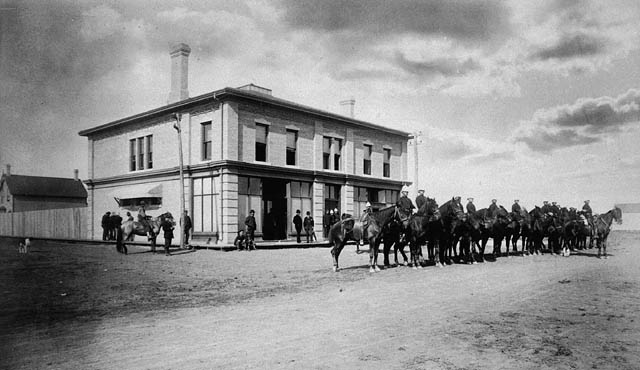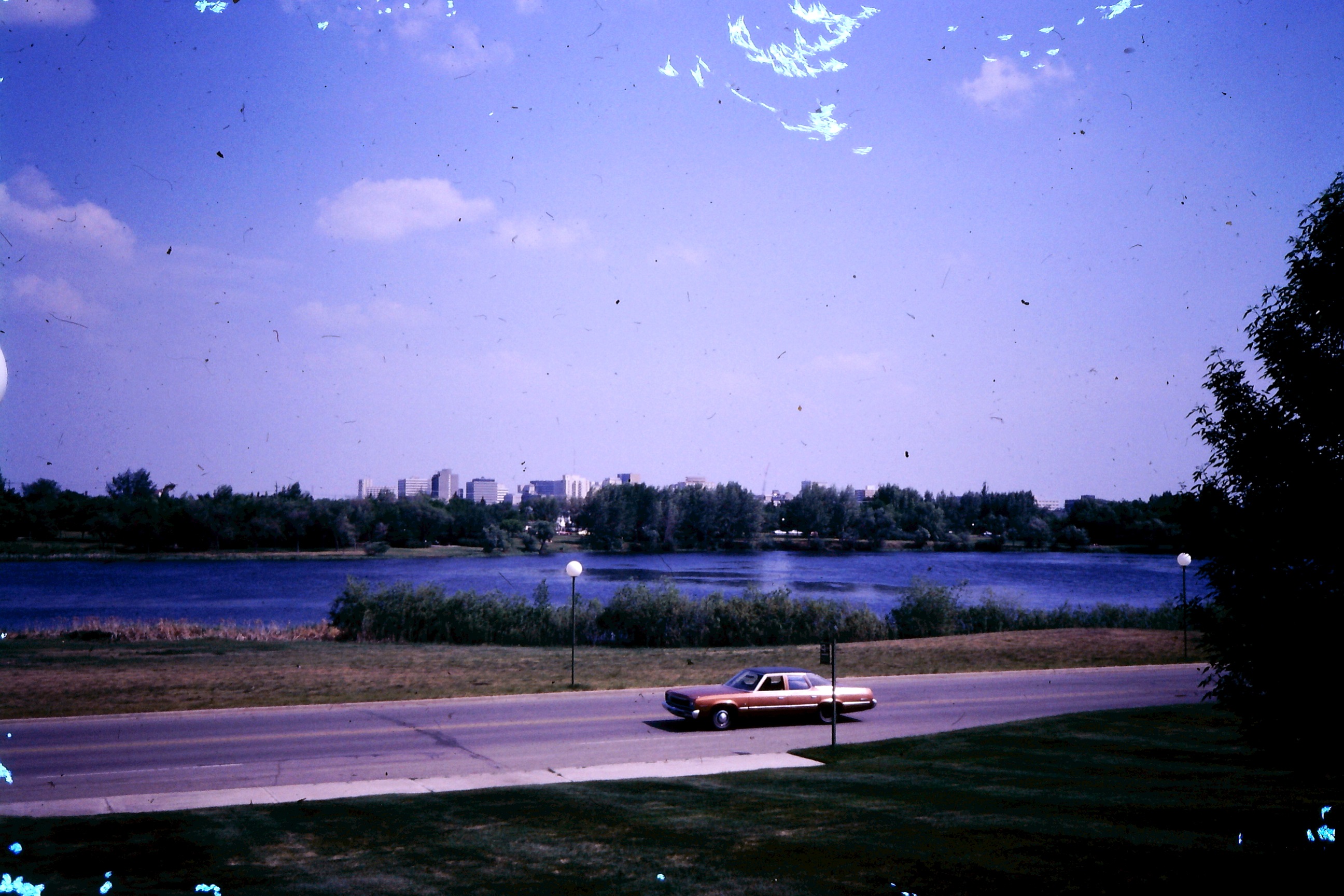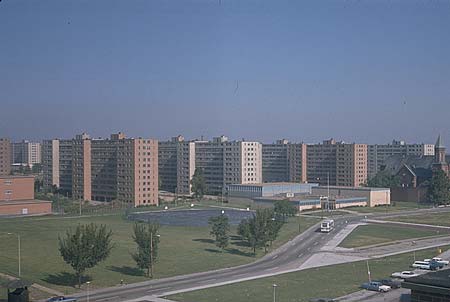|
Wascana Park
Wascana Centre is a 930-hectare (9.3 km2/2,300 acre/3.6 mi2) urban park built around Wascana Lake in Regina, Saskatchewan, Canada, established in 1912 with a design from renowned architect Thomas Mawson. The park is designed around the Saskatchewan Legislative Building and Wascana Lake. High-profile features include the University of Regina, Royal Saskatchewan Museum, Conexus Arts Centre, Saskatchewan Science Centre, and CBC Regional Broadcast Centre. Wascana Centre brings together lands and buildings owned by the City of Regina, University of Regina, and Province of Saskatchewan. The park is located immediately south of the city's downtown core, bordered by residential areas on the east, south and west, and on the south-east edge it spills out onto open Saskatchewan prairie along Wascana Creek. Wascana lake was created in 1883 by damming Wascana Creek, a low flow seasonal run-off stream, to serve as a reliable water reservoir for the town and railway, and ... [...More Info...] [...Related Items...] OR: [Wikipedia] [Google] [Baidu] |
Regina, Saskatchewan
Regina () is the capital city of the Provinces and territories of Canada, Canadian province of Saskatchewan. The city is the second-largest in the province, after Saskatoon, and is a commercial centre for southern Saskatchewan. As of the 2021 Canadian census, 2021 census, Regina had a List of cities in Saskatchewan, city population of 226,404, and a List of census metropolitan areas and agglomerations in Canada, Metropolitan Area population of 249,217. It is governed by Regina City Council. The city is surrounded by the Rural Municipality of Sherwood No. 159. Regina was History of Northwest Territories capital cities, previously the seat of government of the Northwest Territories, North-West Territories, of which the current provinces of Saskatchewan and Alberta originally formed part, and of the District of Assiniboia. The site was previously called Wascana ("Buffalo Bones" in Cree), but was renamed to Regina (Latin for "Queen") in 1882 in honour of Queen Victoria. This decisio ... [...More Info...] [...Related Items...] OR: [Wikipedia] [Google] [Baidu] |
Wascana Creek
Wascana Creek is a river in the Canadian province of Saskatchewan. It is a tributary of the Qu'Appelle River. Originating in the fields east of Regina near Vibank, Wascana Creek travels south-east for approximately before turning back west at Tyvan. The creek then travels in a north-westwardly direction following Highway 33 through Regina, where it was dammed by the Canadian Pacific Railway to create Wascana Lake. The lake was created to supply water for steam locomotives and to create a decorative image in Regina. Below the lake, the creek leaves Regina and ends at the Qu'Appelle River about 1 mile west of Lumsden. Sherwood Forest Bridge and Albert Memorial Bridge are two of the bridges that cross Wascana Creek. Near the mouth of the river in the Wascana Valley, is a provincial recreation site called Wascana Trails that were developed for use in the 2005 Canada Summer Games. A 2011 study by Environment Canada found the creek to have high levels of pollution. Wa ... [...More Info...] [...Related Items...] OR: [Wikipedia] [Google] [Baidu] |
Saint John, New Brunswick
Saint John is a seaport city of the Atlantic Ocean located on the Bay of Fundy in the province of New Brunswick, Canada. Saint John is the oldest incorporated city in Canada, established by royal charter on May 18, 1785, during the reign of King George III. The port is Canada's third-largest port by tonnage with a cargo base that includes dry and liquid bulk, Breakbulk_cargo, break bulk, containers, and cruise. The city was the most populous in New Brunswick until the 2016 census, when it was overtaken by Moncton. It is currently the second-largest city in the province, with a population of 69,895 over an area of . French explorer Samuel de Champlain landed at Saint John Harbour on June 24, 1604 (the feast of St. John the Baptist) and is where the Saint John River (Bay of Fundy), Saint John River gets its name although Mi'kmaq and Maliseet, Wolastoqiyik peoples lived in the region for thousands of years prior calling the river Wolastoq. The Saint John area was an important area ... [...More Info...] [...Related Items...] OR: [Wikipedia] [Google] [Baidu] |
Rockwood Park, Saint John
Rockwood Park is a city park in Saint John, New Brunswick. It is 2,200 acres (890 hectares) in size, with ten lakes and 55 trails and footpaths. The park includes upland Acadian mixed forest, several hills and several caves, as well as freshwater lakes, with a trail network, and a golf course. It is located in the eastern area of the North End and is one of Canada and New Brunswick's largest urban parks. It is also a Stonehammer Geopark site. The park is open from dawn until dusk and has free parking. Visitors can enter and exit from either the Lake Drive at Lily Lake or Hawthorne Avenue Extension at Fisher Lakes. Paved pathways connect to amenities such as the Interpretation Centre, the Kiwanis Play Park, and the Bark Park. History The park was designed by Calvert Vaux, one of the designers of New York City's Central Park, in the mid-19th century. The park was initially established around Lily Lake during the late 19th century, and was named in a vote by citizens in the area a ... [...More Info...] [...Related Items...] OR: [Wikipedia] [Google] [Baidu] |
List Of Urban Parks By Size
A list of urban parks by size includes parks at least or and contained entirely within a locality's municipal or metropolitan boundary. List This is a list of the largest parks located entirely within a metropolitan area. Park systems are included, but not ranked because park systems are networks that contain multiple parks. Not all parks listed below are classified as urban parks by their managing authority. See also * Urban parks in Canada References Footnotes Citations {{Reflist Urban Parks An urban park or metropolitan park, also known as a municipal park (North America) or a public park, public open space, or municipal gardens ( UK), is a park in cities and other incorporated places that offer recreation and green space to re ... Urban * ... [...More Info...] [...Related Items...] OR: [Wikipedia] [Google] [Baidu] |
Pippy Park
Pippy Park is a urban park located in the city of St. John's, Newfoundland. It is the second largest provincially-managed urban park in Canada, after Fish Creek Provincial Park in Calgary, Alberta. The park is a popular camping, hiking and recreational park within the city, and incorporates numerous groomed and wilderness-style hiking/skiing trails, a miniature golf course, a 9-hole and an 18-hole golf course, a driving range, and a public access trailer park with limited tent camping facilities. Trails within the park link to the Grand Concourse walking trails. Pippy Park incorporates the main campus of Memorial University of Newfoundland and the Memorial University of Newfoundland Botanical Garden at Oxen Pond, as well as the Ridge Road campus of the Marine Institute of Memorial University of Newfoundland and the Ridge Road and Prince Philip Drive campuses of the College of the North Atlantic. The park also includes the Confederation Building complex, which houses the Newfo ... [...More Info...] [...Related Items...] OR: [Wikipedia] [Google] [Baidu] |
Big Dig (Regina, Saskatchewan)
Wascana Centre is a 930-hectare (9.3 km2/2,300 acre/3.6 mi2) urban park built around Wascana Lake in Regina, Saskatchewan, Canada, established in 1912 with a design from renowned architect Thomas Mawson. The park is designed around the Saskatchewan Legislative Building and Wascana Lake. High-profile features include the University of Regina, Royal Saskatchewan Museum, Conexus Arts Centre, Saskatchewan Science Centre, and CBC Regional Broadcast Centre. Wascana Centre brings together lands and buildings owned by the City of Regina, University of Regina, and Province of Saskatchewan. The park is located immediately south of the city's downtown core, bordered by residential areas on the east, south and west, and on the south-east edge it spills out onto open Saskatchewan prairie along Wascana Creek. Wascana lake was created in 1883 by damming Wascana Creek, a low flow seasonal run-off stream, to serve as a reliable water reservoir for the town and railway, and whic ... [...More Info...] [...Related Items...] OR: [Wikipedia] [Google] [Baidu] |
Modernist
Modernism is both a philosophical and arts movement that arose from broad transformations in Western society during the late 19th and early 20th centuries. The movement reflected a desire for the creation of new forms of art, philosophy, and social organization which reflected the newly emerging industrial world, including features such as urbanization, architecture, new technologies, and war. Artists attempted to depart from traditional forms of art, which they considered outdated or obsolete. The poet Ezra Pound's 1934 injunction to "Make it New" was the touchstone of the movement's approach. Modernist innovations included abstract art, the stream-of-consciousness novel, montage cinema, atonal and twelve-tone music, divisionist painting and modern architecture. Modernism explicitly rejected the ideology of realism and made use of the works of the past by the employment of reprise, incorporation, rewriting, recapitulation, revision and parody. Modernism also rejected t ... [...More Info...] [...Related Items...] OR: [Wikipedia] [Google] [Baidu] |
Thomas Church (landscape Architect)
Thomas Dolliver Church (April 27, 1902 – August 30, 1978) was a 20th century landscape architect based in California.UC Berkeley, College of Environmental Design: About the archives . accessed 7.28.2014 He is a nationally recognized as one of the pioneer s of in |
Minoru Yamasaki
was an American architect, best known for designing the original World Trade Center in New York City and several other large-scale projects. Yamasaki was one of the most prominent architects of the 20th century. He and fellow architect Edward Durell Stone are generally considered to be the two master practitioners of "New Formalism". During his three-decade career, he and his firm designed over 250 buildings. His firm, Yamasaki & Associates, closed on December 31, 2009. Early life and education Yamasaki was born on December 1, 1912, in Seattle, Washington, the son of John Tsunejiro Yamasaki and Hana Yamasaki, ''issei'' Japanese immigrants. The family later moved to Auburn, Washington, and he graduated from Garfield Senior High School in Seattle. He enrolled in the University of Washington program in architecture in 1929, and graduated with a Bachelor of Architecture (B.Arch.) in 1934. During his college years, he was strongly encouraged by faculty member Lionel Pries. He ear ... [...More Info...] [...Related Items...] OR: [Wikipedia] [Google] [Baidu] |
University Of Saskatchewan
A university () is an institution of higher (or tertiary) education and research which awards academic degrees in several academic disciplines. Universities typically offer both undergraduate and postgraduate programs. In the United States, the designation is reserved for colleges that have a graduate school. The word ''university'' is derived from the Latin ''universitas magistrorum et scholarium'', which roughly means "community of teachers and scholars". The first universities were created in Europe by Catholic Church monks. The University of Bologna (''Università di Bologna''), founded in 1088, is the first university in the sense of: *Being a high degree-awarding institute. *Having independence from the ecclesiastic schools, although conducted by both clergy and non-clergy. *Using the word ''universitas'' (which was coined at its foundation). *Issuing secular and non-secular degrees: grammar, rhetoric, logic, theology, canon law, notarial law.Hunt Janin: "The university ... [...More Info...] [...Related Items...] OR: [Wikipedia] [Google] [Baidu] |
Landscape
A landscape is the visible features of an area of land, its landforms, and how they integrate with natural or man-made features, often considered in terms of their aesthetic appeal.''New Oxford American Dictionary''. A landscape includes the physical elements of geophysically defined landforms such as (ice-capped) mountains, hills, water bodies such as rivers, lakes, ponds and the sea, living elements of land cover including indigenous vegetation, human elements including different forms of land use, buildings, and structures, and transitory elements such as lighting and weather conditions. Combining both their physical origins and the cultural overlay of human presence, often created over millennia, landscapes reflect a living synthesis of people and place that is vital to local and national identity. The character of a landscape helps define the self-image of the people who inhabit it and a sense of place that differentiates one region from other regions. It is the dyn ... [...More Info...] [...Related Items...] OR: [Wikipedia] [Google] [Baidu] |





.jpg)

